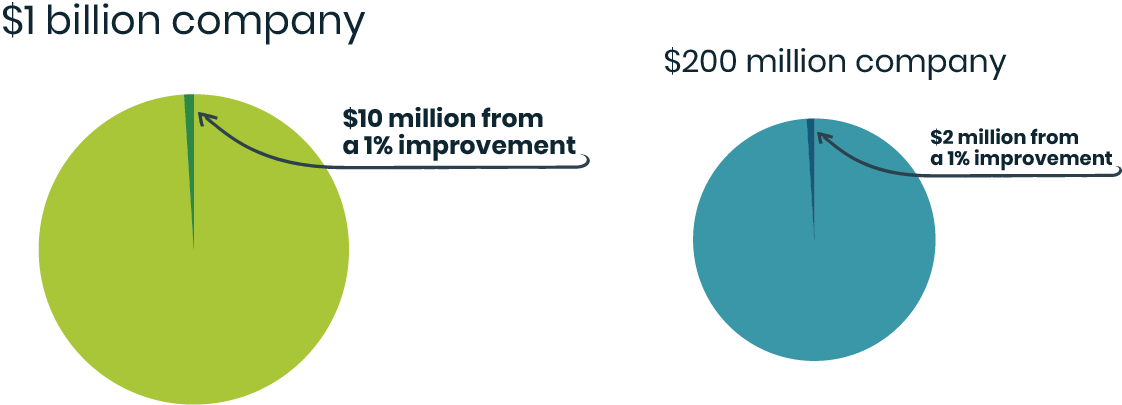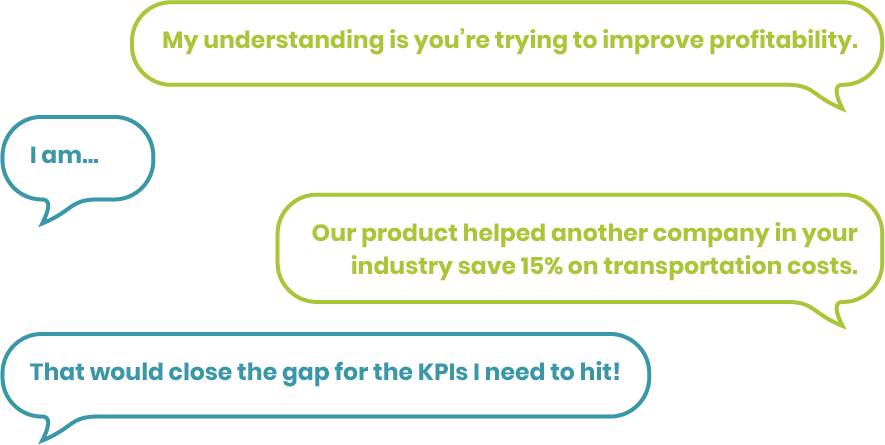Don’t Underestimate the Power of a 1% Improvement
Buyers only care about one thing regarding what you’re selling: your solution’s business outcomes. No matter how great your features and functions are, buyers mostly want to know how your solution will improve the performance of their business. Since business relies heavily on financial performance, it’s up to you to demonstrate your solution’s economic impact, and you should have that conversation as soon as possible. Especially since nowadays, buying groups are much further down their buying journey even before they engage with sellers. The problem is that you don’t know if you can help them early in the sales cycle. Without more information and validation from the client, you can’t say you’ll improve profits by 1 percent or 10 percent by improving revenue or lowering expenses. This is where the power of just a 1 percent improvement can help you close the deal.
What is the Power of One?
The Power of One is the financial benefit from a 1 percent improvement. This improvement can be in Areas of Financial Performance or Operational KPIs relevant to business units improved by your solutions. For example, say you are talking to Marketing, which focuses on financial performance revenue growth, and Operational KPIs such as customer churn. Suppose the Power of One is $10 million for revenue growth and $2 million for customer retention. Those numbers are great conversation starters and can effectively capture your buyer’s attention. The Power of One does more than get your solution noticed. It also provides insights into the most significant areas of leverage for improving performance, which is extremely useful during account planning. It a financial focus to your conversation with buyers and offers a way to uncover a buyer’s expected business outcomes. Lastly, the Power of One helps you communicate with buyers in their language, separates you from competitors, and builds credibility, which goes a long way toward gaining your customer’s confidence.
Many companies I have worked with use internally a concept like the Power of One. One retailer would calculate the benefit of a one-day inventory reduction and discuss how the freed-up cash could be used to invest in a greater online presence.
If your customers use something like the Power of One, why shouldn’t your sales organization?

Using the Power of One Strategically
When you’re ready to use the Power of One, it helps to know how and during which stage of the sales process to apply it. We recommend using it during account planning to identify those KPIs that deliver the most significant benefits. You can also use it in the initial stages of the sales process. A word of caution: Do not position the Power of One as a promise. It’s not a proposal or a business case. It is only a conversation starter. By looking through the Power of One lens before you talk to the customer, you can identify what the buyer is focused on. This can then help you find new areas to explore with the customer.
Having the Conversation
How do you effectively fit the Power of One into your sales conversations? Before you get to this point, you must confirm the company’s goals. You might say, for example, “My understanding is you’re trying to improve profitability.” If you’ve done your homework, they’ll often answer yes, but sometimes priorities change. You want to make sure your proposed target is still a goal. Once you know the goal, you need to figure out which buyers align with that goal, and their associated strategies and Operational KPIs. After you’re clear on those details, share your observations about how other companies have improved in the relevant areas. Ideally, tell the buyer something they do not know. Then talk about how your solutions have helped others in the industry with similar goals, strategies, and initiatives.
Once you’ve laid this groundwork, you’ll share the Power of One as a conversation starter with the aim of discovering the client’s clear goals. The Power of One for Areas of Financial Performance is easily tailored to individual customers since it’s based on their reported financial statements. The Power of One for Operational KPIs are typically based on industry averages but scaled to the size of the customer.

Let’s explore a couple of examples.
In these examples, the Power of One benefits are scaled to a company with $1 billion in revenue and industry average for the operational KPIs.
Manufacturing
In this example, you sell solutions that help manufacturers lower total manufacturing cost. You have confirmed that a goal is to improve profitability by improving operational efficiencies. The Chief Operating Officer has shared that she is most focused on are labor and materials costs. You share how your solutions have helped others in the COO industry better manage labor and materials. Then you share that for a company their size using some industry average, a 1% improvement in labor is around $2 million and materials around $6 million. Don’t be surprised if the executive looks at you like you have three eyes! This is the first time a seller has shared this kind of information.
The next question is how these numbers compare to their internal analysis. The most common response is that they are close enough. Sometimes they will share their numbers with you.
Another question is, what is the goal? Suppose the COO shares that the goal is to reduce both labor and materials by 5 percent. What valuable information. Using the Power of One results based on the industry averages, the COO just shared with you she wants to reduce labor by $10 million ($2 million x 5) and materials by $30 million ($6 million x 5). You can use this to glean insights into the relative importance of your solutions. If your solution can reduce labor costs by $5 million or more, you may be the COO’s new best friend. If your solutions can only reduce labor costs by a few hundred thousand dollars, they will not be of much interest.
Network Service Provider
In this example, you sell solutions that help customers develop greater customer insights which help grow revenue. You are talking with the CMO at the network service provider. You have confirmed that the company aims to increase revenue by reducing customer churn, increasing cross-sell/upsell, and attracting more customers. You share how your solutions can help.
Now it’s time for the Power of One. You share that for a company the size of the CMO, a one-percent improvement for each of the KPIs is around $1 million. You know what to ask next. How does this compare to their internal analysis, and what’s the goal?
Cyber Security
You provide solutions that help cyber security companies develop new products faster. You could talk about how your solution lowers application development costs, but the biggest benefit is increased revenue from new products.
You are talking to the VP of Product Development. He shares how the CFO wants to grow faster by shortening new products' time to market. You share how your solutions can help. And using some industry averages and scaling the benefit to the executive’s company revenue size, a one-percent improvement in time-to-market would generate a $2 million annual revenue benefit. Let’s say you know that for the VP’s industry, you know your solutions can often cut product development time by 25 percent. In this case, you may say, “Using industry averages, if we could do for you like we have done for others in your industry, the benefit would be $50 million in annual revenue.” Remember, don’t make this sound like a promise. It’s a conversation starter.

The Power of One Aligns You with Your Customer
Whatever the details of your solution and industry, the Power of One makes it easier to align with your customer. It helps you identify what’s important to them, find the intersection between that focus and what your solution can do, and quantify the potential impact as a 1 percent improvement.
Remember, buyers care about one thing regarding your product primarily: how your solution can help them achieve their desired outcomes. Despite all the information available on public companies, your knowledge of their financials is still incomplete, especially during your initial conversations with buyers. However, you need to communicate the potential financial impact of your solution, and the Power of One allows you to do just that.
Discover the Power of One and revolutionize your sales approach with a free copy of our book, “Insight-led Selling.” Gain valuable insights into how to become a trusted advisor, deliver personalized value, and drive meaningful customer interactions. Unlock the secrets to successful insight-led selling and the Power of One.
